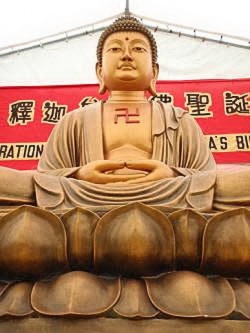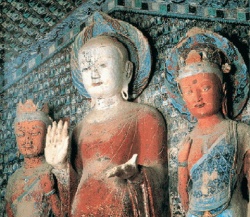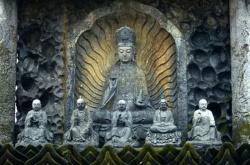What Does the Name 'Sanghāta' Mean?
What does the title of this sutra mean? - This is a question that could be (and has been) contemplated for a good, long time, without exhausting the possibilities. As one linguist who studied the Sanskrit and Khotanese versions of the Sanghāta put it, "the cryptic aspects of the sutra also extend to its title."
In standard Sanskrit, sanghāta is a term meaning the ‘fitting and joining of timbers’ or ‘the work done by a carpenter in joining two pieces of wood,’ and can refer to carpentry in general. It has a specialized use in a few Buddhist Sanskrit texts, where it means ‘vessel’ or ‘jar,’ and this image of ‘something that contains’ is evoked several times within the sutra, when Buddha calls the Sanghāta a ‘treasury of Dharma.’
Whether we take sanghāta as having the sense of joining or connecting that it has in standard Sanskrit, or the sense of holding or containing it can have in Buddhist Sanskrit, the question still remains as to just what is connected or held.
One possible interpretation is that what is connected are sentient beings, and they are joined or connected by the Sanghāta to enlightenment. This suggestion—that what the Sanghāta joins is sentient beings to enlightenment—was offered by Kirti Tsenshab Rinpoche during an oral transmission of the text in 2003. In this, we find an idea that we readers and reciters are the material that the Sanghāta is working on, as it shapes us, and connects us to our enlightenment in such a way that we will never turn back. This, indeed, is what Sarvashura initially requests the Buddha to give: a teaching that can ensure that the young ones are never disconnected from their path to enlightenment.
How the Text’s Early Translators Understood 'Sanghāta'
Another way to approach the question as to why this discourse is called ‘Sanghāta’ is to see how previous translators rendered the title.
Translators of the Sanghāta have taken a fairly broad range of stances on this question. The two earliest translations we have—the Khotanese and the first of the two Chinese translations do not translate the name at all. (This is the strategy the English translation is taking as well.) This decision by the Khotanese translator of the Sanghāta to leave the name ‘Sanghāta’ in Sanskrit is particularly striking, because the general strategy that Khotanese translators took was to translate the meanings of words wherever possible, rather than leaving them in Sanskrit. Thus in Khotanese even the word ‘Buddha’ is translated, trying to capture the meaning rather than treating it as a proper name and leaving it as ‘Buddha,’ as we do in English.
The Chinese translation was produced by an Indian scholar working in China in the 6th century, while the Khotanese was produced some time before the middle of the fifth century, a time when contact between Indian and Khotanese scholars would still have been relatively easy. If there was any common knowledge, or received wisdom as to what the title meant, it seems likely that these translators would have had access to it. Since they did not choose to translate the titles into local languages, we can speculate that either they thought it important to leave the name of the sutra in Sanskrit for some reason, or they felt that there was no easy answer to the question: what exactly does the name mean?
The next two translations to be completed—into Tibetan and then into Chinese for a second time—both chose to translate the term ‘sanghāta’ into their own languages, but did so in quite different ways.
The second translator into Chinese was more courageous than the first, and rendered the title of the sutra in Chinese as The Sutra of the Great Gathering of the Holy Dharma. (In Chinese, Ta chi hui cheng fa ching in the Wade-Giles transliteration system, or Ta ji-hui zheng-fa jing in Pinyin.)
The Tibetan translation of ‘Sanghāta’ is sanctioned by the authoritative glossary used for the translation of Sanskrit terms in to Tibetan, known as the Mahavyutpatti. This glossary was compiled in the ninth century in Tibet by a team of respected translators, under the royal decree of the Tibetan king Tri Ralpachen. In it, ‘Sanghāta sutra’ is translated as 'The Sutra of the Pair of Monastic Assemblies,’ or ‘The Sutra of the Pair of Sanghas’ (dge ’dun zung gi mdo). This seems to suggest that what are paired, or joined together, are two assemblies of Sangha. It seems we now have one clear interpretation of the meaning of Sanghāta in the title. As understood by these translators, ‘Sanghāta’ in the title refers to a pair of monastic assemblies.
This leads us to ask—which two monastic assemblies are paired? During the Sanghāta, groups are assembling right up to the final pages of the sutra, but most of those who gather are not identified even as Buddhists, much less monastic assemblies. In the Sanghāta, there are no two clear groups of ordained Sangha.
But there is one prominent pair of groups in the Sanghāta: the groups of young and old beings. Just who the young and old are is another topic open to discussion, but it is clear that a group of young beings is brought together with a group of old beings in the Sanghāta. Indeed, in the question that initiates the dialogue, Sarvashura asks for a teaching that can benefit young and old at the same time—a teaching for a pair of groups.
But the plot thickens. In most (but not all) of the editions of the Tibetan canon, or bka’ ‘gyur (kagyur), the title of the text is is simply rendered as ‘Zung,’ omitting the reference to monastic assembly or Sangha. And in the text itself, in all the editions of the canon, wherever we had ‘Sanghāta’ in Sanskrit, the text says simply ‘zung,’ and does not mention any assembly or Sangha.
This leaves us with a sense of sanghāta as a joining or coupling of two things—two things that might (or might not) be assemblies. Perhaps old and young practitioners are joined. Perhaps what is joined or connected is us to enlightenment. Perhaps what the Sanghāta connects changes in dependence on its readers and reciters.
In any case, the term ‘sanghāta’ keeps all these possible meanings up for our contemplation. This survey of some of the possible meanings certain does not close the discussion. To continue puzzling over what the name ‘Sanghāta’ could refer to, visit our discussion forum under the heading ‘What Does Sanghāta Mean?’
A Further Note on ‘Sanghāta’ in Sanskrit
Please note that the ‘sangha’ in Sanghāta does not appear to be the same as the ‘sangha’ in Sangha. In ‘Sanghāta’ the second 'a' is long (this the long marker over the ‘a’) and the 't' is retroflex.


